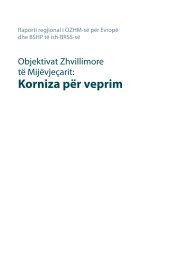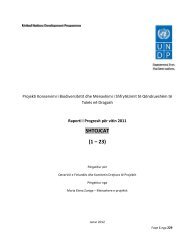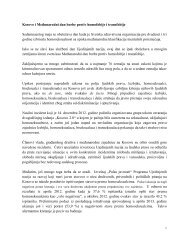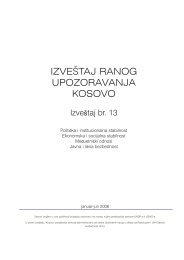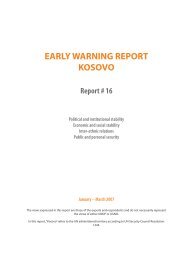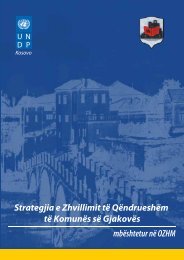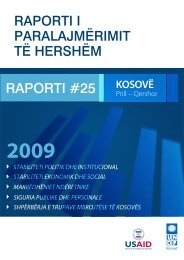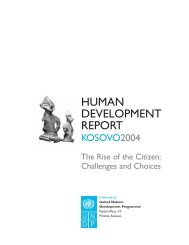Kosovo Human Development Report 2010 - UNDP Kosovo - United ...
Kosovo Human Development Report 2010 - UNDP Kosovo - United ...
Kosovo Human Development Report 2010 - UNDP Kosovo - United ...
You also want an ePaper? Increase the reach of your titles
YUMPU automatically turns print PDFs into web optimized ePapers that Google loves.
political dialogue. Some are a legacy of<br />
<strong>Kosovo</strong>’s ethnically-fractured past. Ethnicized<br />
democracies (i.e., democracies<br />
where voting patterns are determined<br />
by ethnic identities rather than by political<br />
values) tend to be particularly<br />
hard for ethnic minorities to penetrate.<br />
<strong>Kosovo</strong>’s enclaves are, in this way, isolated<br />
from a wider political process<br />
and ethnic minorities within the enclaves<br />
(for example, a <strong>Kosovo</strong>-Albanian<br />
in a <strong>Kosovo</strong>-Serb enclave) might struggle<br />
to participate on an equal footing<br />
at the local level. <strong>Kosovo</strong>’s ongoing<br />
population movement is aggravating<br />
tensions between communities rather<br />
than resolving them, as families seek to<br />
resettle from areas where they are no<br />
longer wanted. Minority groups such<br />
as the <strong>Kosovo</strong>-RAE have for too long<br />
been seen as a threat to social unity,<br />
rather than an important and welcome<br />
part of social diversity. These ongoing<br />
divides threaten <strong>Kosovo</strong>’s deeply cherished<br />
goals of a stable and prosperous<br />
future as a full partner at the European<br />
table.<br />
5.3<br />
Who is affected by<br />
exclusion from political<br />
participation?<br />
(i) Women, particularly the rural<br />
poor: the cultural norms that keep<br />
many women at home, without<br />
jobs (the unemployment rate for<br />
women is 55 percent compared to<br />
39 percent for men), looking after<br />
children and often out of education<br />
mean that women struggle<br />
to assert their political rights. 185 Illiteracy<br />
rates are three times higher<br />
among women than among men.<br />
While the absolute numbers of illiterate<br />
people are decreasing, the<br />
rate remains unchanged for women.<br />
The apathy of the unrepresented<br />
applies particularly to the most<br />
excluded women; they must overcome<br />
exhausting cultural and family<br />
barriers before even reaching<br />
82 | KOSOVO HUMAN DEVELOPMENT REPORT <strong>2010</strong><br />
a political system that has made<br />
much noise but shown little real<br />
determination to bring more fairness<br />
and opportunty to their lives.<br />
Nearly a third (30 percent) of seats in<br />
<strong>Kosovo</strong>’s central and municipal Assemblies<br />
are reserved for female members.<br />
186 However, the reality of participation<br />
contrasts starkly with their legal<br />
rights. A bare one fifth (20 percent)<br />
of public administration jobs are held<br />
by women – only a marginal increase<br />
since 1999. Implementation of legislation<br />
promoting the role of women<br />
in political and economic spheres remains<br />
weak, without sufficient institutional<br />
accountability to provide the<br />
requisite budgetary support and oversight.<br />
187 Gender equality officers have<br />
not been appointed in all ministries<br />
and gender equality committees have<br />
only been established in two out of 30<br />
municipalities. The President of <strong>Kosovo</strong><br />
appointed a woman as chairperson of<br />
the Central Election Commission (CEC)<br />
on 14 May 2009. However, the ninemember<br />
Presidency of the Assembly<br />
does not have a female member, and<br />
the President’s seven-member Cabinet<br />
has only two women. Only two of<br />
the 13 committees of the Assembly of<br />
<strong>Kosovo</strong> were chaired by women. No<br />
woman sits on the 11-member Committee<br />
on Foreign Affairs. The Committee<br />
on Internal Affairs and Security and<br />
that on Legislation and Judicial have a<br />
single female member each. Overall,<br />
out of 144 members of various assembly<br />
committees, only 31 percent are<br />
women.<br />
Representation of women is little<br />
better at the local level. Women held<br />
between 22 and 28 percent of the<br />
seats in each municipal assembly in<br />
2009. No municipal assemblies were<br />
led by women, and only ten vice chairs



